

Medical assistant jobs are in high demand. The field is expected to grow by 24 percent through 2024, much higher than the average for most other jobs.
You know your way around EMR systems and how to deliver an excellent experience to patients. You shouldn’t also need to be an expert at writing a resume. It can be challenging to discuss your experience and qualifications correctly on your resume.
Our medical assistant resume examples have helped medical assistants land jobs at great hospitals and physician’s offices around the country, so they’re the perfect place for you to get started.
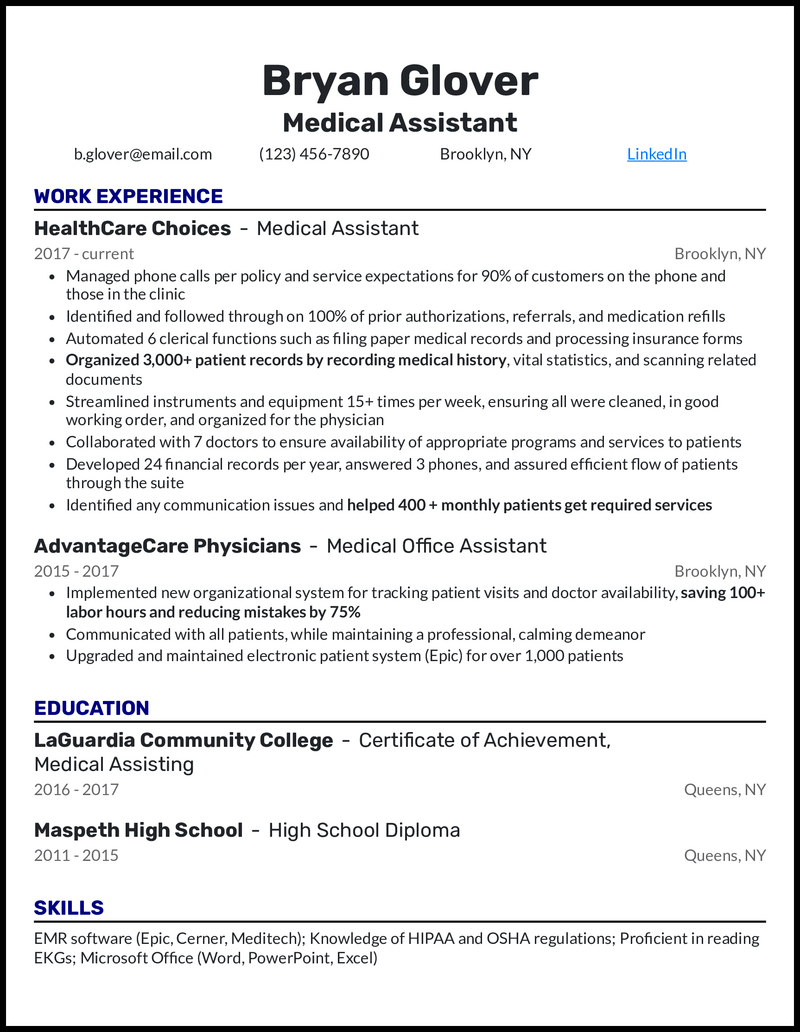
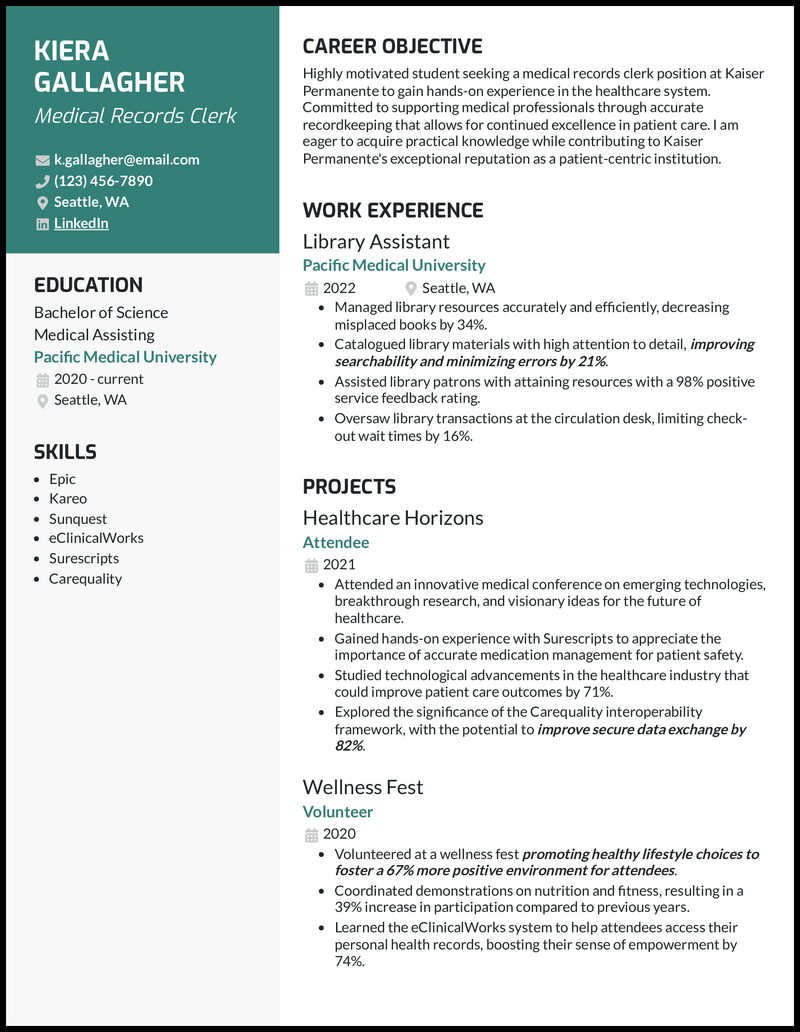

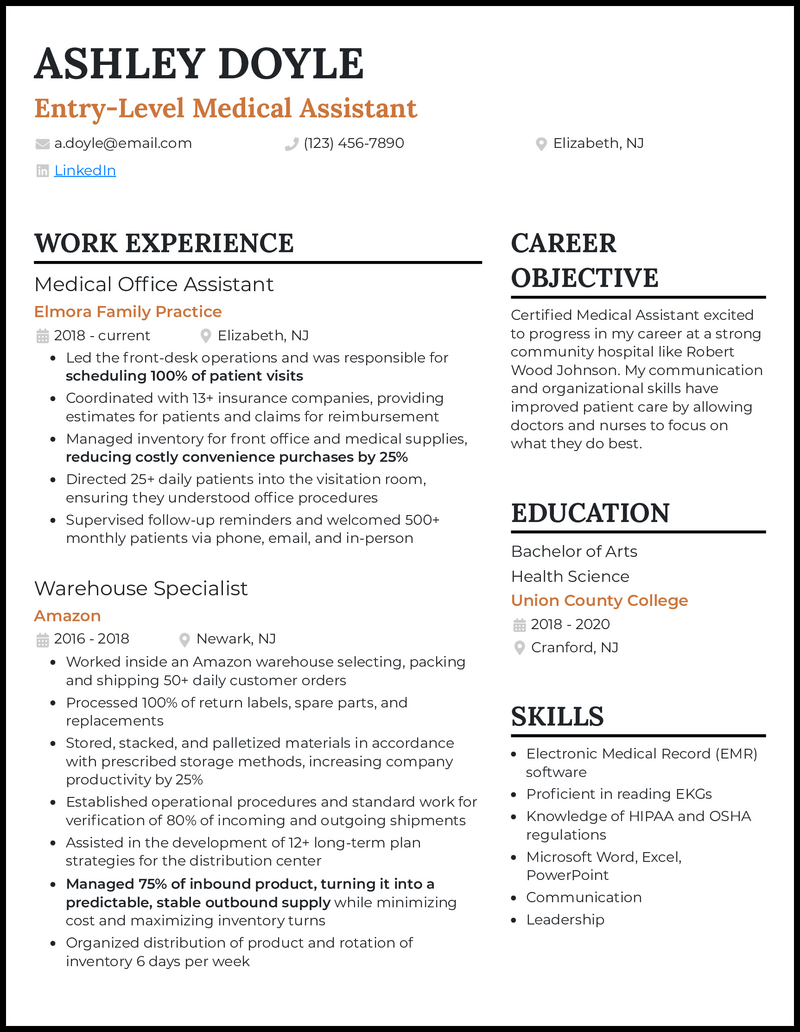
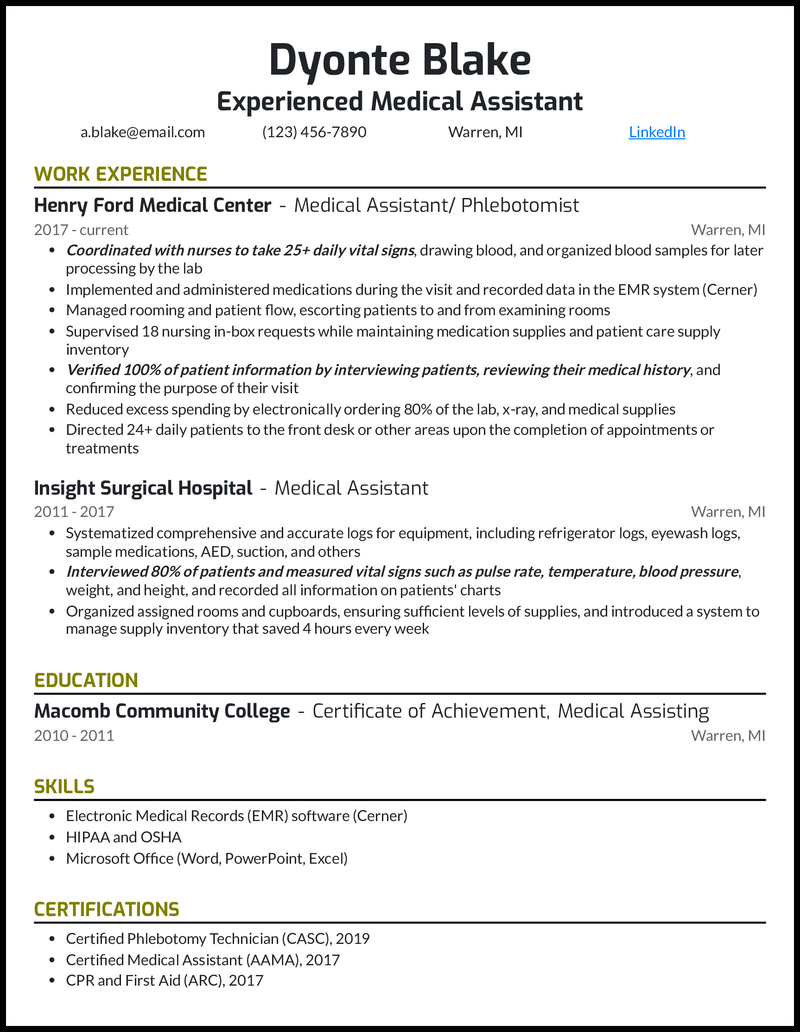



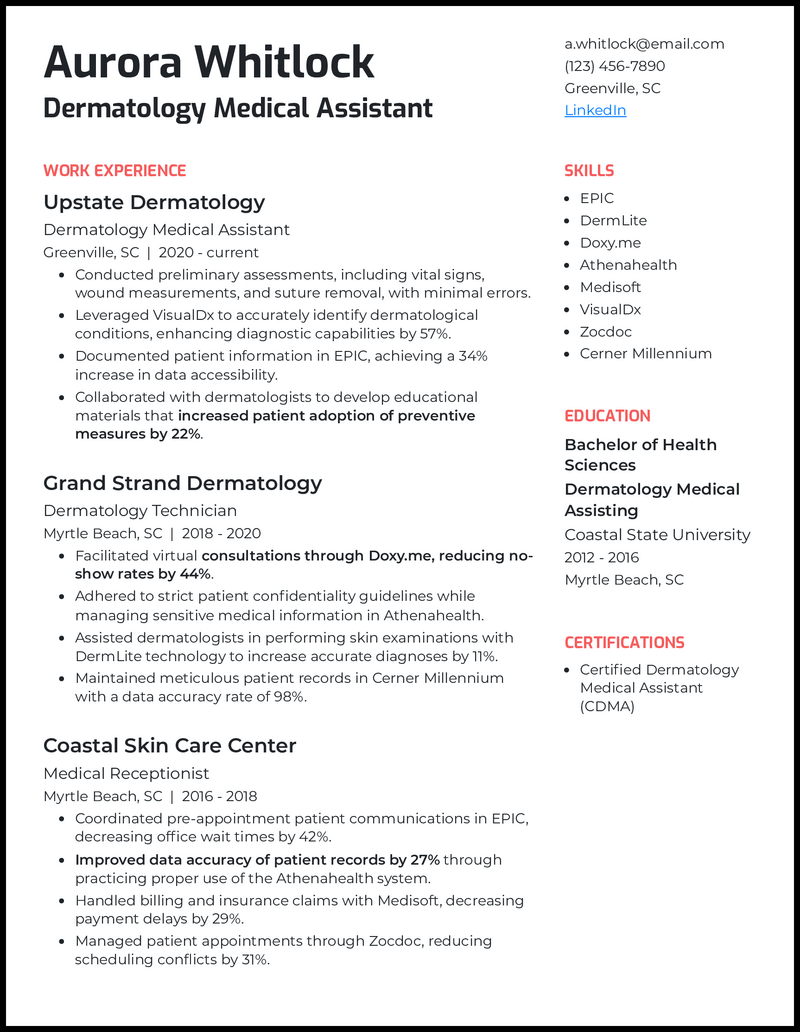

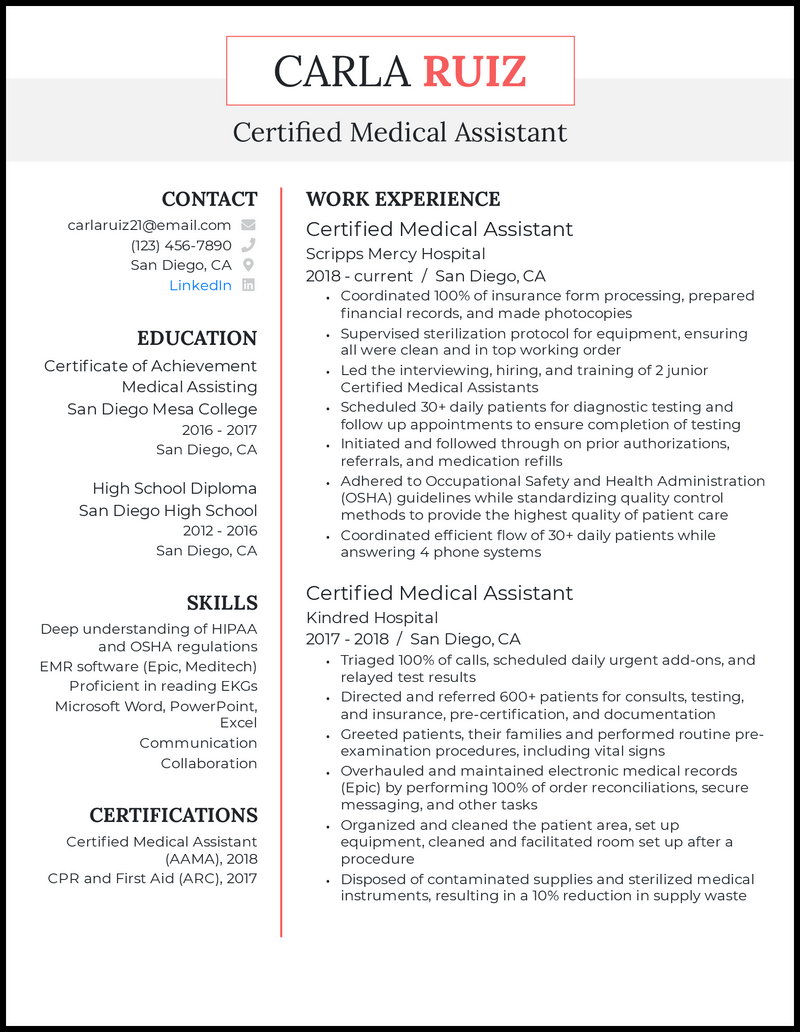

Aside from the actual content of your resume, the formatting you use determines whether a hiring manager will seriously consider your medical assistant resume. When formatted correctly, your resume will be easy to read, have a logical flow, and be complete.
If your resume lacks these formatting qualities, there’s a likelihood that hiring managers won’t take your resume seriously; if it makes their job more difficult, they may toss your application. To properly format your resume, you’ll want to pay special attention to the following:
![]()
You have a few resume formats to choose from, with these being the most popular in 2024:
Each type of format can be considered for your resume, but reverse-chronological formatting is what we tend to recommend for any medical assistant resume.
Since recruiters in the medical industry are routinely inundated with 100+ resumes per job posting, they prefer resume formats that lend themselves to quick skimming. A reverse-chronological resume does that while highlighting your most recent job title.
![]()
When a recruiter determines that they want to reach out for an interview, make sure they know how to reach you. Using a large font, position your name on the left side or top center of your resume, and use a smaller font to include the medical assistant job title you seek. Have your contact info available, too.
Your resume header should consist of:
Your header is also a good place to add a (professional) pop of color. Take a look at these resume examples and the visual sample below to get inspiration for a wide variety of header styles!

![]()
We don’t want to sound dramatic, but we can’t overemphasize how important it is that your medical assistant resume is ATS-friendly for every job you apply to in 2024.
What is ATS? Simply put, Applicant Tracking System software (ATS) became an integral part of the recruitment process after the explosion of the internet led to sharp increases in online job applicants.
ATS will scan your resume, searching for keywords by recognizing your resume formatting. For this reason, it’s critical that your medical assistant resume matches ATS standards, lest your application gets thrown out without ever being reviewed.
Feeling overwhelmed? Check out our resume builder to ensure your formatting is done correctly.

Job hunting is stress-inducing for most people, and many think of resume and cover letter writing as the peak of their anxiety.
Thankfully, writing an effective resume doesn’t have to be overwhelming. The key is to take it one section at a time. Using our resume builder, you can avoid all the frustration of writing and re-writing improperly formatted sections. Save yourself the time that could be spent on the job search. Let’s address the essentials:
![]()
Though similar in many ways, a resume objective and summary statement are slightly different paragraphs to consider including in your medical assistant resume. Both are highly specified, short (two to three sentence) paragraphs, but an objective will emphasize why you’re seeking the job, whereas a summary highlights the skills you’ve honed throughout your career.
Consider including a resume objective if you’re going through a substantial career change, such as a dental assistant to a surgical assistant. An objective can also be a helpful place to emphasize why you’re seeking a particular role (and use up white space) if you have minimal experience.
On the other hand, resume summaries focus on skills and specializations developed throughout your career. Consider adding a resume summary if you’re a seasoned medical assistant with 10+ years of experience.
If you decide to include a resume summary or objective, you’ll need to commit to customizing it for every job to which you apply. Let’s review some great examples of highly-specialized resume summaries and objectives.
![]()
Want to improve my career prospects with a job that will get me experience in the medical field.
What we don’t like: This objective contains no specific details. It should include the job title you’re seeking, one to three specific skills that will help you contribute to the work environment, and the business name to which you’re applying. This objective consumes precious space on your resume without providing any useful information.
OSHA and HIPAA-compliant medical assistant with 6+ years of proven experience serving 100+ daily patients in fast-paced ER environments. Seeking an opportunity at Trinity United Healthcare to continue serving patients and medical staff in the Pediatric Orthopedics department, where my efficient workflow and compassionate care management can help ensure more patients are served per hour.
What we like: Specific skills, years of experience, job title, hospital name, and work contributions were mentioned. A resume objective like the one above and the visual sample below deserve the space they take up on your resume.
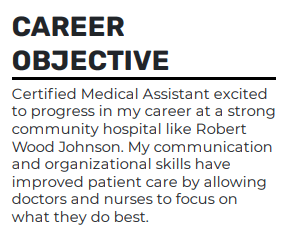
![]()
I have years of experience working well as a medical assistant.
What we don’t like: Like the first objective example, this summary provides little substance. It’s vague and short.
Detail-oriented medical assistant with 20+ years of experience in clinics and hospitals across Idaho, with a depth of knowledge of HIPAA, ERM software, medical terminology, and Microsoft Office. I enjoy working in fast-paced environments that enable me to improve patient comfort, physician efficiency, and operating systems.
What we like: This summary gets right to the point, discussing some of the most valuable skills a great medical assistant will possess while highlighting years of work experience and how they would add value to the business.
![]()
Your work experience section should include two to four positions you’ve had throughout your career. That means, if you’ve been a medical assistant for many years, you don’t need to include information about the job you had in high school. Instead, focus on the most recent 10-year period, and narrow that list to the most relevant.
Note: if you’ve just entered the workforce, there’s nothing wrong with highlighting less relevant job experience or even class projects and volunteer experience, but we’ll touch on that later.
![]()
Chunking your job description text with bullet points is a great way to enhance readability and reduce a visually dense or overwhelming resume.
Here are a few medical assistant bullet points that incorporate this advice:
We like these bullet points because they use active voice and action words while avoiding personal pronouns such as “I” or “my,” and they have consistent punctuation written in the past tense.
![]()
The only thing our above bullet point examples are missing is quantifiable metrics (numbers). Numbers are an essential element in your medical assistant resume, and you should aim for at least 50 percent of your bullet points, including them.
Why are metrics important?
Numbers positively impact your resume in two ways. First, the visual interest helps break up text and draw in hiring managers’ eyes. This is critical, as it will encourage them to read your resume more thoroughly. Second, numbers are impressive because they demonstrate your proven job performance. In the context of your medical assistant resume, numbers say a thousand words.
Here are a few places you can leverage metrics from your medical assistant work experience:
Here are a few examples of job description bullet points that would work well for any medical assistant resume.
![]()
One of the most under-utilized sections on most resumes is the skills section. Many medical assistants don’t realize that this section is essential for catching the eye of ATS. Since ATS works by matching keywords in your resume to pre-selected words (skills) chosen by hiring managers, you want to ensure you’re listing the right skills.
Ideally, your medical assistant resume should include both hard and soft skills. Hard skills such as “CRM software proficiency” can be trained. They’re highly specific to the job title you’re seeking, and they demonstrate your ability to utilize the skill (they’re easily measurable).
On the other hand, soft skills are skills you can include on any resume. These skills, such as “organization” or “attention to detail,” are universally important. However, it’s difficult to measure these skills; they’re often overused and may be disregarded by hiring managers.
Focus mostly on hard skills while incorporating a few particularly relevant soft skills. Include 6 to 10 resume-relevant skills for your medical assistant resume, such as:
![]()
Becoming a medical assistant has a few different educational routes. Some employers are satisfied with on-the-job training experience, while others seek applicants with one-year certificates or an associate’s degree. Legally, there are no formal training requirements to become a medical assistant.
When listing your education, avoid including too many details unless you’re a recent graduate with limited work experience. As you gain work experience, you can reduce details about your education, including only your most advanced education level.
Though not required by all employers, most prefer CPR and First Aid Certification; if you have your Certified Medical Assistant Certification (AAMA), include it. Like Certified Phlebotomy Technician (CASC), other specialized certifications will make your resume even more impressive.
Wow employers with your most impressive certs.
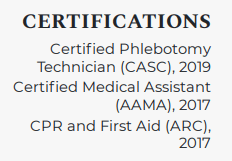
You may wonder if you should include resume-related interests and hobbies in your piece. Generally, we don’t recommend medical assistants have these on their resumes, but there are instances it may be appropriate:
![]()
Want to stand out from the competition? Then make sure the employer sees that you read the job description, that you take their time seriously, and that you genuinely want this position.
Show you care by customizing your resume to every job you apply for.
![]()
Finally completed your resume? Step back from your masterpiece and come back with fresh eyes for the edits. Once you return to it, you may be surprised that a few grammatical errors made it prominently onto your resume.
![]()
Wahoo, cheers to you! You’ve taken the first step to upping your resume game. We’ve covered many topics, including formatting techniques, ATS, skills section, work experience tips, and more. We know you’re ready for the next step: